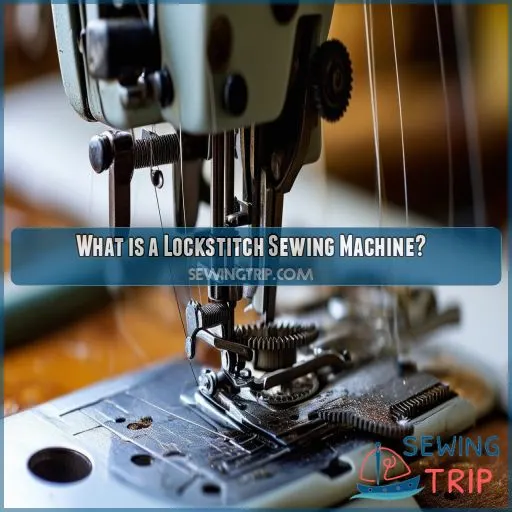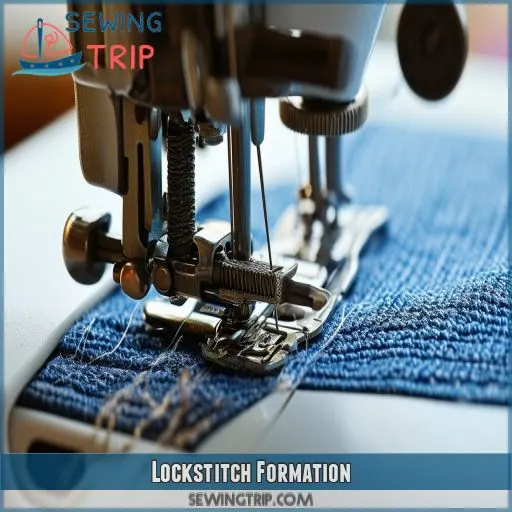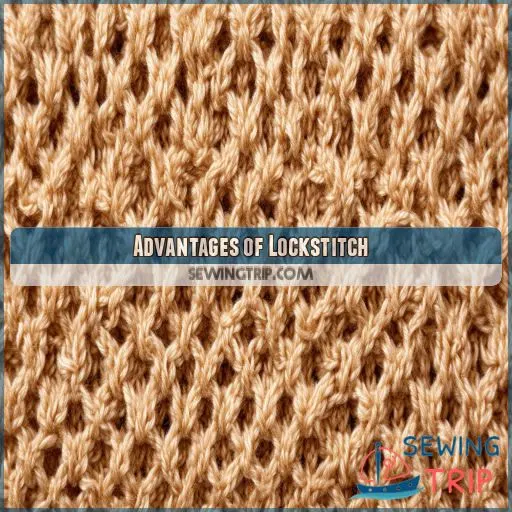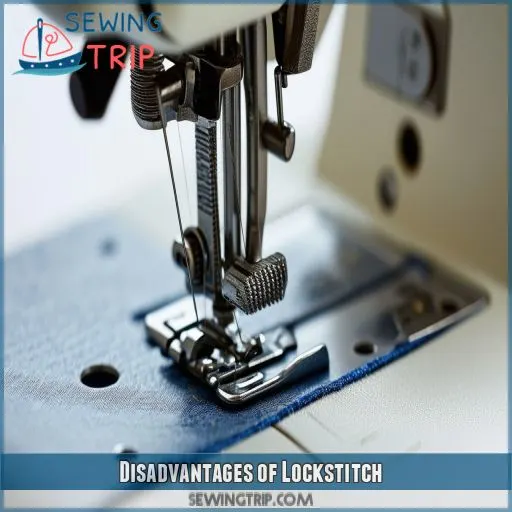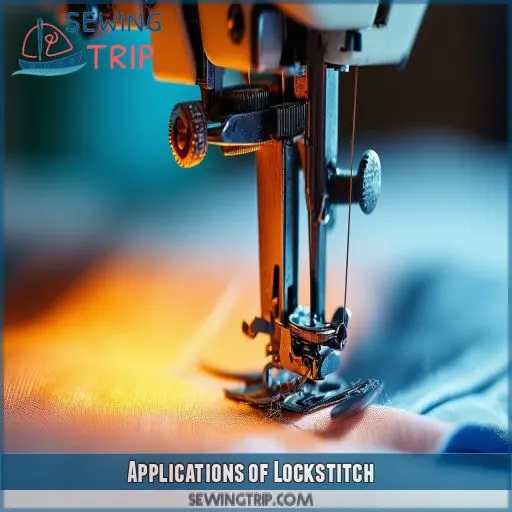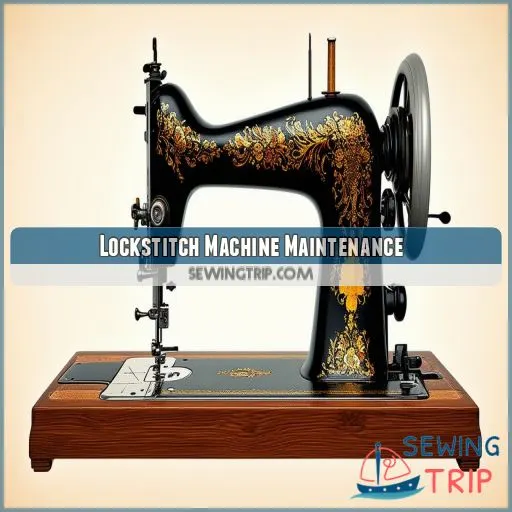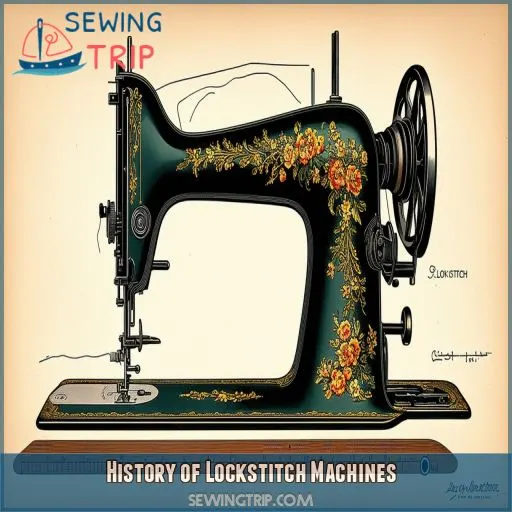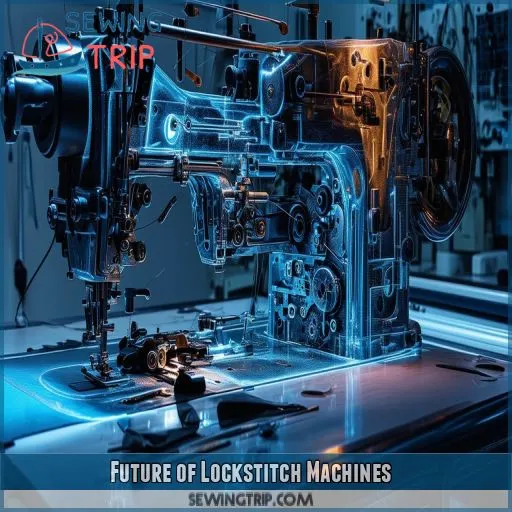This site is supported by our readers. We may earn a commission, at no cost to you, if you purchase through links.

Truly understand what happens to unlock the development of mastery in your work and be your problem-solving mechanism. Let us reveal the mystery of this vital tool: the dance of the needle, and the bombinate movement of the bobbin.
Let’s see how a lockstitch sewing machine sews these incredibly accurate and robust stitches you rely on
Table Of Contents
- Key Takeaways
- What is a Lockstitch Sewing Machine?
- How Does a Lockstitch Sewing Machine Work?
- Lockstitch Formation
- Advantages of Lockstitch
- Disadvantages of Lockstitch
- Applications of Lockstitch
- Lockstitch Machine Maintenance
- History of Lockstitch Machines
- Future of Lockstitch Machines
- Frequently Asked Questions (FAQs)
- Conclusion
Key Takeaways
- The lockstitch sewing machine is like a well-choreographed dance between needle and bobbin, creating stitches that are tougher than a two-dollar steak. It’s the unsung hero of the garment world!
- Picture this: as the needle dives down like an Olympic swimmer, it forms a loop that the bobbin hook catches faster than you can say "thread." This tag-team effort creates a stitch that’s equally pretty on both sides of the fabric.
- The feed dog mechanism is the unsung roadie of the sewing world, moving your fabric along so smoothly you’ll wonder if it’s secretly buttered. Without it, you’d be stuck sewing in place like a hamster on a wheel!
- Maintaining your lockstitch machine is easier than keeping a cactus alive. A little TLC goes a long way – clean it, oil it, and check the tension regularly, and it’ll be humming along happily for years to come. It’s like having a loyal pet that never needs feeding!
What is a Lockstitch Sewing Machine?
The lockstitch sewing machine is your regular workhorse for most sewing projects. This would likely be the most common type of machine that one might find in many homes and small workshops.
This nifty device creates a robust, durable stitch by interlocking two threads—one from the needle and another from a bobbin underneath the fabric. The magic comes in when these threads "lock" together inside the layers of the fabric, creating a stitch that looks equally good on both sides.
Accurate lockstitch bobbin tension paired with quality thread produces perfect stitches. Be aware of needle wear, and make sure your machine is compatible with your fabrics. Regular maintenance is what keeps your lockstitch machine running.
Whether you’re hemming jeans or sewing a quilt, the seams of this versatile machine with a reliable lockstitch will help you out in any situation
How Does a Lockstitch Sewing Machine Work?
You’ll find that a lockstitch sewing machine works through the coordinated action of three main mechanisms: the needle, the bobbin and shuttle, and the feed dog. These components work together to create the lockstitch by interlacing the upper thread from the needle with the lower thread from the bobbin, while the feed dog moves the fabric forward for each stitch
Needle Mechanism
The mechanism for the lockstitch sewing machine is the needed pll. The needle goes up and down, taking the top thread to form a strong and even stitch through each other and the fabric at regular intervals.
To illustrate the mechanism of the needle:
- In this, the needle bar rises and falls rapidly.
- Thread passes through the needle’s eye
- Penetration of the fabric layers by a needle
- Thread makes a loop underneath the material
Ensuring proper thread tension, having sharp needles, and regular servicing are sufficient for this. Keep in mind that quality threads and lubrication at the right time are essential to the smooth running.
Bobbin and Shuttle Mechanism
A mechanism consisting of a bobbin and shuttle forms the core of your lockstitch sewing machine. When the sewing machine is used, the shuttle revolves; this revolution allows some thread to be given out from the bobbin. This given-out thread interlocks with the thread from the needle to form a strong stitch.
Now, here’s why this mechanism is important:
- Creates a nicely balanced, very strong stitch
- It allows smooth, continuous sewing.
- It reduces the breakage of threads and their tangling.
It is understanding bobbin winding, tension, and capacity that can make a difference in taming your sewing machine’s performance.
Feed-dog Mechanism
The feed-dog is a straightforward yet essential system to move the fabric under your lockstitch sewing machine. Here’s how it works:
- There are the toothed metal bars that rise from underneath the needle plate.
- These bars, gripping the fabric, move it forward.
- The feed dogs drop, making way for the penetration of the needle into the fabric.
You’ll need to adjust, maintain, and, at times, replace your feed dogs to keep them performing well. There are varieties of feed dogs for various fabrics and sewing purposes to ensure you get clean, even stitches.
Lockstitch Formation
This is the heart of your sewing machine’s magic: lockstitch formation. You turn the crank or engage the motor, and suddenly, what seems like many parts begin to do something almost choreographed. First, you have the needle that goes up and down through the fabric, carrying with it the top thread. You have, at the same time, the bobbin case below; it also carries the bottom thread. Here is how it all comes together:
- The needle comes down, and with the top thread, a loop is made.
- This loop is caught by the rotating hook
- The hook bears the loop over the bobbin
- The bottom thread is pulled through the loop.
• Because both threads are pulled tight, the lockstitch is created.
While adjusting your fabric and the size of the needle, the correct tension of the thread should be ensured in the stitch balance. Standard cleaning of the machine, oiling for running properly cam mechanism, gear, and wheel mechanisms are essential. Keep in mind that perfect lockstitch formation is the guarantee for professional-looking sewing.
Advantages of Lockstitch
Now that you understand how a lockstitch forms, let’s explore its advantages. The lockstitch’s popularity stems from its exceptional strength and durability. You’ll find this stitch type excels in various applications, making it a go-to choice for many sewers.
Here are three key benefits of using a lockstitch:
- Elasticity and strength: The interlocking threads provide a secure hold, allowing for stretch without breaking.
- Fabric versatility: From delicate silks to heavy denim, lockstitch adapts to various materials.
- Decorative potential: Its clean appearance on both sides makes it ideal for visible stitching.
Whether you’re using a mechanical sewing machine or an industrial sewing machine, the lockstitch’s versatility shines through. It’s equally effective on a cylinder bed sewing machine for curved seams or a blind hem sewing machine for invisible finishes. This adaptability is why you’ll find lockstitch in everything from everyday garments to high-end fashion pieces
Disadvantages of Lockstitch
While lockstitch sewing machines are wonderfully versatile, they’ve a few weaknesses for which you need to be prepared. This intricate mechanism can be a blessing and a curse. Some of the crucial disadvantages are:
Thread tension problems: if not adjusted properly, you’ll have puckered fabric or loose stitches.
• Speed of machine: High speeds may result in skipped stitches or thread breakage.
• Thickness of Fabric: A thick material may cause deflection of the needle or uneven stitches.
You’ll want to be careful about needle size and thread quality to avoid these pitfalls. The lockstitch machines can also be finicky about thread tension, and adjustments could be frequent while transitioning between different fabrics. They also tend to come undone if a thread is broken, which takes time to resume in a deadline situation. Regular maintenance is essential if you need your lockstitch sewing machine to run like a well-oiled cat.
Applications of Lockstitch
Because of their versatility and durability, lockstitch sewing machines are the workhorses of the apparel industry, so you can rightfully expect to find a lockstitch machine at work in everything from haute couture to home decor.
Here are four key applications in which lockstitch really shines:
- Garment construction
- Quilting and patchwork
- Leather and vinyl work
- Home decor projects
From jeans hemming to complex quilting, it’s a red-hot choice due to its strength and neat appearance on both sides of the fabric. It works exceptionally well for things that will launder and be worn frequently. On the other hand, not everything is suitable for lockstitch. If, for example, you sew much stretchy fabric, you should consider a serger instead. Or, you may want to use a zigzag sewing machine instead. For those quick, temporary seams, you might prefer a portable or hand crank sewing machine for convenience. Having some problems with the lockstitch? Proper tension is where it all begins—the secret to a fine stitch
Lockstitch Machine Maintenance
It is essential to take good care of lockstitch machines by differing from their applications. In a word, regular maintenance will prolong the life span of your most central lockstitch sewing machine. Here are three major maintenance tasks:
- Daily cleaning of the thread path and bobbin area.
- Oil moving parts weekly with the correct viscosity needle lubricant
- The thread tension and the bobbin winder should be checked once a month.
Remember your pulley system; that’s the heart of your lockstitch sewing machine. Be it a handheld sewing machine or one of the more extensive sewing and quilting machines—whatever your model—it depends on the kind of maintenance you get out of it. Look for wear, especially in high-friction areas. A well-maintained lockstitch machine is much like an instrument fine-tuned—it will work nicely when you need it most. By following these tips, you’re ensuring your machine will keep humming along—stitch after perfect stitch.
History of Lockstitch Machines
Now that you know how to keep your lockstitch running, let’s talk briefly about its history. The lockstitch sewing machine was what opened up the garment industry to mass production and, thus eventually to globalized trade.
The following are four of the most compactkimilestones in the history of lockstitching:
- 1830: Barthélemy Thimonnier invents the first patented mechanical sewing machine
- 1845: Elias Howe invents the lockstitch mechanism.
- 1851: The improvement of the design by Isaac Singer; first mass production
- 1889: Singer manufactures the first electric sewing machine
These contributions of the inventors changed the often laborious clothing production into an efficient and mechanized industry. The effect of the lockstitch machine was overwhelming; this machine quickly made garment production easy and promoted global trade. With technological advancement, the machines evolved from simple mechanical devices to computerized marvels that could do intricate stitching on various materials, including leather. Much of today’s button sewing machines and specialized leather sewing machines came from these humble early innovations.
Future of Lockstitch Machines
As we look to the future, lockstitch machines continue to evolve, embracing technological advancements and meeting modern demands. You’ll see these machines adapting to new challenges while maintaining their core functionality. Here are some exciting developments on the horizon:
- Increased automation and AI integration for precision stitching
- Enhanced sustainability features, including energy-efficient motors
- Improved durability with self-lubricating components
- Smart connectivity for remote operation and diagnostics
These innovations are blurring the lines between traditional lockstitch machines and specialized equipment like embroidery and coverstitch machines. You’ll find hybrid models that combine lockstitch capabilities with buttonhole and multi-needle embroidery functions, offering versatility for various projects. As manufacturers focus on efficiency and sustainability, you can expect quieter operation, reduced vibration, and eco-friendly materials in future models. Whether you’re a hobbyist or professional, these advancements will make your sewing experience smoother and more enjoyable, allowing you to tackle complex projects with ease
Frequently Asked Questions (FAQs)
What are the disadvantages of lockstitch?
You’ll find lockstitch has its drawbacks. It’s less stretchy, can unravel easily if a thread breaks, and creates more puckering on some fabrics. It’s also tougher on thread due to repeated pulling, potentially causing wear and tear
What is the function of a lockstitch sewing machine?
Like a skilled dancer, a lockstitch sewing machine weaves magic. You’ll use it to join fabrics securely. It creates strong, neat seams by interlocking upper and lower threads. It’s versatile, handling various materials and stitching styles with ease
Do we still use the lockstitch sewing machine?
Yes, you’ll still find lockstitch machines in use today. They’re popular for home sewing and small-scale production due to their versatility and reliable stitch quality. Many modern garments are made using this tried-and-true technology
What are the advantages of lockstitch sewing machine?
You’ll love the lockstitch machine‘s versatility. It’s great for various fabrics and creates sturdy, neat seams on both sides. You can easily pivot fabric, making it perfect for intricate designs. Plus, it’s reliable for everyday sewing tasks
How does a lockstitch sewing machine work?
You’ll find a lockstitch machine fascinating. It uses two threads: one from above, one below. As you sew, the needle plunges down, looping the top thread around the bottom one, creating a secure stitch on both sides
What is a lock stitch sewing machine?
You’ve stumbled upon a gem in the sewing world. A lock stitch machine‘s your trusty sidekick, using two threads to create durable seams. It’s the backbone of garment construction, ensuring your creations stand the test of time
What is a lockstitch & how does it work?
A lockstitch interlocks two threads – one from the needle, one from the bobbin. As you sew, the needle pushes thread through fabric, forms a loop, and the bobbin hook catches it, creating a secure stitch on both sides
What is lock stitch & how does it work?
Like a dance between threads, a lock stitch intertwines upper and lower threads. You’ll see it form when the needle pushes through fabric, loops with bobbin thread underneath, and pulls tight. It’s strong, versatile, and commonly used in sewing
How fast can a typical lockstitch machine sew?
You’ll be amazed at a typical lockstitch machine’s speed. It can sew up to 5,000 stitches per minute, zipping through fabric like lightning. That’s over 80 stitches per second! Imagine how quickly you’d finish projects
Can lockstitch machines handle multiple layers of thick fabric?
Did you know lockstitch machines can sew up to 5,000 stitches per minute? You’ll be pleased to hear they can handle multiple layers of thick fabric. With the right needle and adjustments, you’re set for heavy-duty projects
Whats the maximum stitch length for lockstitch machines?
You’ll find most lockstitch machines can handle stitch lengths up to 5-7mm. However, industrial models may offer longer options. It’s best to check your machine’s manual, as maximum length can vary between manufacturers and models
Are computerized lockstitch machines more efficient than manual ones?
You’ll find computerized lockstitch machines more efficient than manual ones. They offer precise stitch control, automatic pattern selection, and programmable settings. You’ll save time, reduce errors, and achieve consistent results across various fabrics and stitch types
How long does a lockstitch machines bobbin typically last?
The life expectancy of your bobbin is a factor in your sewing volume and the type of thread you’re using. Usually, a bobbin is suitable for about 2-3 garments or 4-6 hours of constant sewing. Be sure to check the quality of the thread being used and tension for best results.
Conclusion
Like a dance of precision and power, the lockstitch sewing machine has revolutionized garment production. You’ve learned how this mechanical marvel works, from the needle’s rhythmic plunge to the bobbin’s intricate interplay.
Understanding how a lockstitch sewing machine works empowers you to troubleshoot issues and master your craft. As you apply this knowledge, you’ll appreciate the machine’s advantages, navigate its limitations, and maintain it effectively.
Whether you’re a hobbyist or professional, embracing the lockstitch mechanism will elevate your sewing skills and open new creative possibilities

